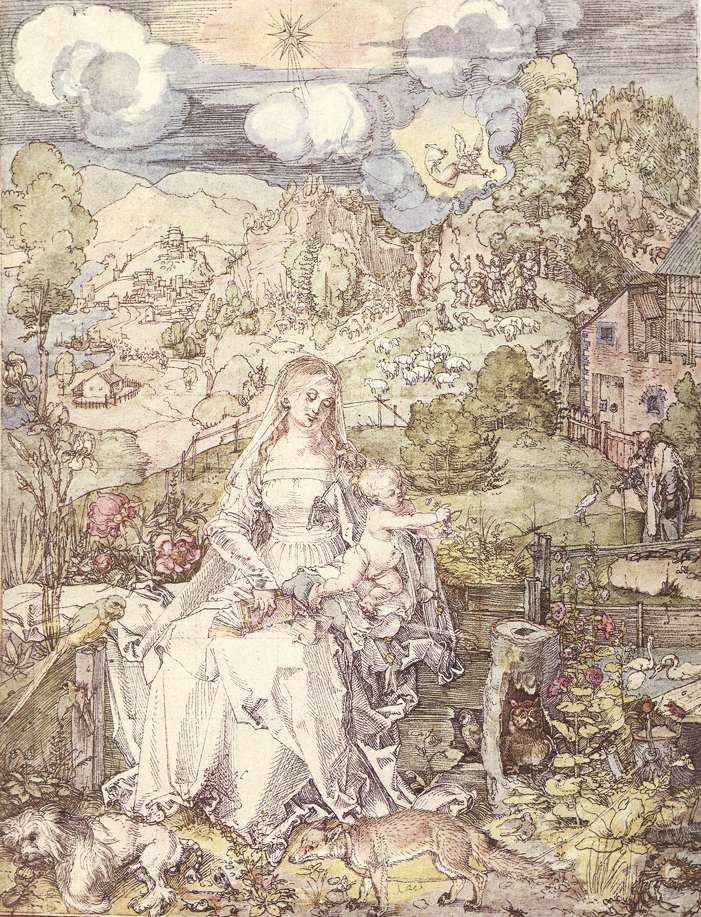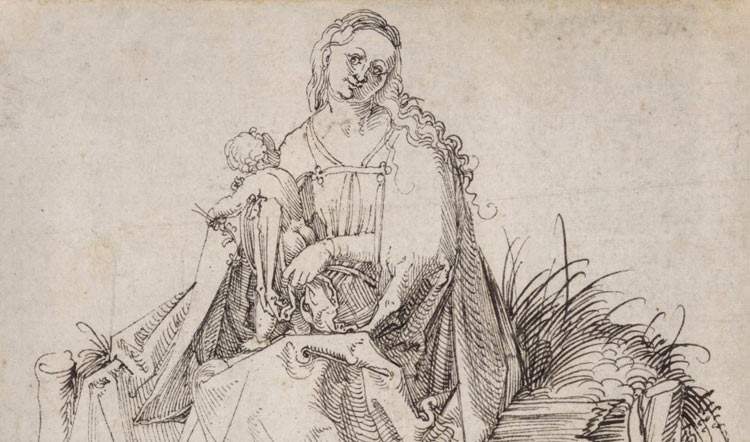It must have been incredulous to the collector who, five years ago, bought a drawing for $30 at an estate auction in Concord, Massachusetts (U.S.), when he realized that according to several authoritative experts it was a work by Albrecht Dürer. A group of scholars, experts on Dürer and the German Renaissance, gathered last week at the British Museum in London to discuss the work (which could be worth a few million euros): a pen drawing sold in 2016 and depicting a Madonna and Child. Below the Virgin’s robe appears Dürer’s monogram, the one formed by the initials A.D., which is often seen in works by the great German Renaissance artist.
Experts who have come out in favor of an attribution to Dürer include Christof Metzger, curator of the Albertina in Vienna and author of several publications on Dürer (even Metzger will include it in the forthcoming catalog raisonné of Dürer) and Giulia Bartrum, former curator of German-area drawings and prints at the British Museum. According to both experts, the drawing may be a preliminary study made around 1503 for the Madonna of the Animals, a drawing preserved in the Albertina in Vienna: the position of the Child changes, but the Virgin is almost identical (even the folds of the robe are arranged in much the same way).
To arrive at this result, the collector had to struggle, as a Boston Globe article reports in detail: in fact, for months he passed the drawing around but encountered widespread skepticism, until, in 2019, he met a U.S. antiquarian, Clifford Schorer, through a bookseller specializing in antique volumes, Brainerd Phillipson, who knew the owner of the drawing. In fact, Schorer had gone to Phillipson’s to look for a gift for a friend of his, and in the bookstore in Holliston, a small town located on the outskirts of Boston, he learned of Phillipson’s friend who had a drawing on which he suspected it was by Dürer. Schorer believed that Phillipson had been mistaken and was talking about an engraving by Dürer (Dürer prints have a good circulation, are not unique pieces, and are of far less value than drawings), but he agreed to view the work. When Schorer went to the collector’s home, however, he was taken by enormous surprise, and already at the first meeting he had reached an agreement with the drawing’s owner and the latter’s wife: an advance of one hundred thousand dollars to take the drawing to London and exhibit it at the Agnews Gallery, an antiquarian gallery in which Schorer holds a share.
The antiquarian had it viewed by a Renaissance paper expert, who established, by the physical and stylistic characteristics of the sheet, the authenticity of the drawing (the sheet is made of linen fiber and is believed to have been produced in northern Italy in the late fifteenth century), and further study revealed against the light the presence of a small watermark (a trident and a ring) that appears in 235 other Dürer drawings. “This watermark is only documented in drawings by Albrecht Dürer,” Metzger commented to the Bsoton Globe. “This was a very, very important proof for me that this drawing is from the period. It is from Dürer’s hand.”
In contrast, Fritz Koreny, former curator at the Albertina, disagrees on the attribution, believing that the work is not by Dürer but, if anything, by his most important pupil, Hans Baldung Grien (“He is very close to Dürer, it was made in his workshop,” Koreny said: what makes him lean toward attributing it to Baldung is the outline, which according to him is different from Dürer’s). Still, we are talking about a work that, even if it were by Baldung, would still be of very high value (for Metzger, however, there are no doubts, since the drawing in his opinion would not be compatible with the pupil’s style).


The drawing was then actually exhibited at the Agnews Gallery in London for a couple of weeks, between last Nov. 20 and Dec. 12. “In this highly refined and hitherto unpublished composition executed in ink on a roughly square sheet of fine linen paper,” reads the exhibition catalog, “the Virgin sits on a grass-filled bench and smiles at the viewer with her head gently tilted to the right. In an unusual departure from traditional iconography, the Child is standing on her knees with a flower in her hand, resting on the fold of her left arm; she turns to look at her mother and presents the viewer with the back of her naked body and bare buttocks. Her face is completely in shadow, but wonderfully suggested. The effect sought is to give her full attention to her mother while she is engaged, or even interrupted, by the viewer. Her curly hair falls over her shoulder and down her back. Her mantle, draped around her shoulders, is of a rich, heavy fabric that falls over her legs and spreads a fur-trimmed hem in opulent folds over the grassy ground. The seat is built with poles and planks planted in the ground and is certainly filled with earth, which provides soil for the grass. Light from the top left provides contrast to the robe and thus space and volume, illuminating the Virgin’s forehead and left cheek so that her eyes, nose, and mouth emerge from the shadowed right side of her face. This particular pose represents one of Dürer’s finest and most finished drawings of the subject. The artist’s continuing engagement with the subject of the Virgin and Child, second only in importance to his involvement with the Passion of Christ, produced fourteen engravings, five woodcuts, twenty paintings, and over seventy drawings and studies. There are, however, only a handful of finished, fully completed drawings.” To the latter category would belong the drawing in question.
The composition is, in the words of scholar Andrew Raftery, “very carefully studied.” Comparison with the Madonna of the Animals in the Albertina, the catalog further states, “reveals a close relationship, especially in the treatment of the drapery, and it seems clear that the artist used it directly in designing his Madonna deglin animali composition. However, it is likely that the drawing belongs to an early stage of the project, in which the artist was working out an alternative position and gesture for the Child, who is seen here standing on the left and twisting toward his mother, and in the final version leaning to the right to pick a flower. [...] It is evidence of a creative process that, as is often the case in Dürer’s work, stretches over many years until a final solution is found. The sheet is signed in an autograph monogram in the same ink as the original drawing. This monogram appears no less than twenty times on Dürer’s autograph drawings dated between 1501 and 1514. Since there is a wide diversity of styles in the creation of the monogram employed by the artist, this stylistic difference can be considered as important additional evidence for establishing a date of c. 1503. The paper has a trident and ring watermark recorded in more than two hundred sheets used by the artist during his lifetime. [...] It has been speculated that the fine paper, a fine and durable linen, most likely originated from a paper mill owned by the Augsburg Fugger family, whose coat of arms was a trident with a ring. Despite later interventions, the design is in superb condition, with only one small woodworm hole on the surface that does not affect the inked surface anywhere.”
As for the possible provenance, it is difficult to say who was the first owner of the work. It has been found that the innermost support, made on paper of the late sixteenth or early seventeenth century, is the same size as the original sheet and has an inscription in brown ink of the same date, ’Modena No. 5’. On the outermost, later support is an inscription in a late eighteenth- or early nineteenth-century hand with the expression ’Alberto Duro.’ These inscriptions suggest that the drawing was acquired by a collector in Italy, where Dürer’s prints and drawings were very popular. It is known that sales of drawings from Dürer’s studio in Nuremberg were made at various times by his heirs, Endres and Ursula Dürer, before the latter sold the entire collection to the merchant and collector Willibald Imhoff in 1557. In 1568 Willibald had inherited the library of his grandfather, Dürer’s closest friend Willibald Pirckheimer, and assembled the largest collection of Dürer’s works in Nuremberg. After Imhoff’s death in 1580, more objects were given away by his son, Karl, before he sold the entire collection in 1588 to Emperor Rudolf II. Other Dürer material was surrendered by Ursula Dürer’s niece, Regina Alnpeck, around 1580, part of which was purchased by Rudolph II’s court artist, Bartholomeus Spranger, whose collection was sold in 1611.
A hypothetical connection with the “Modena” inscription, the exhibition catalog notes, is “Duke Francesco I d’Este whose family had moved to Modena in 1598 after being forced to cede Ferrara to the pope. Francesco built a new Ducal Palace in Modena and amassed a collection the bulk of which was sold during the mid-18th century to Augustus the Strong of Dresden. The present drawing, however, probably came to France, where it may have ended up during the nineteenth century in the collection of Count Hubert de Pourtalès known to have sold four Dürer drawings to the Maison Carlhian, Paris, in 1919. In one case the drawing can be identified with certainty. André Carlhian, of the Maison Carlhian, Paris, in partnership with Joseph Duveen, recorded in the Duveen inventories in October 1919 the purchase and sale of a Woman in Dutch Costume of 1521 by Dürer, to Joseph E. Widener. On the same support as the ’Alberto Duro’ inscription, the present drawing has a number written in pencil, ’36.43’ in similar handwriting and in the same 4-digit format as the 1919 inventory number recorded in the Duveen catalog and on the Dürer drawing now in Washington. A register made in the 1950s mentions the presence of the Virgin and Child with a Flower in the Carlhian family collection.”
In the exhibition catalog, the drawing is published as a work by Albrecht Dürer. Now there is anticipation for further scholarly contributions and the release of Metzger’s catalog raisonné.
 |
| Buy a drawing for $30, and experts say it's an autograph by Dürer |
Warning: the translation into English of the original Italian article was created using automatic tools. We undertake to review all articles, but we do not guarantee the total absence of inaccuracies in the translation due to the program. You can find the original by clicking on the ITA button. If you find any mistake,please contact us.